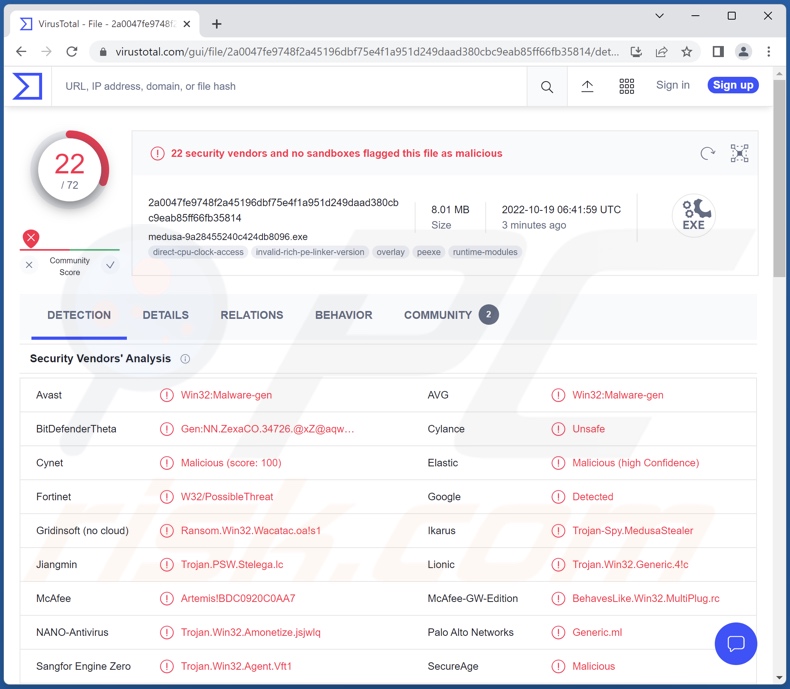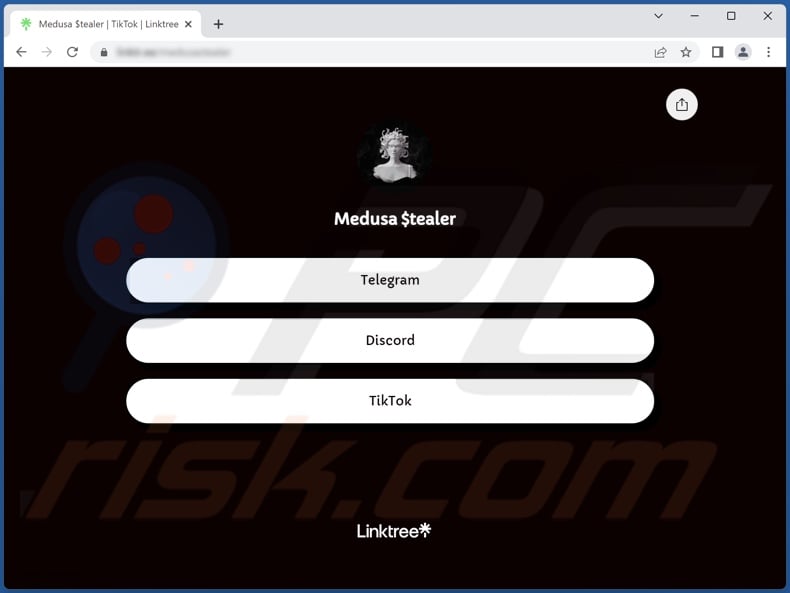How to eliminate the Medusa Stealer malware from your operating system
TrojanAlso Known As: Medusa Stealer virus
Get free scan and check if your device is infected.
Remove it nowTo use full-featured product, you have to purchase a license for Combo Cleaner. Seven days free trial available. Combo Cleaner is owned and operated by RCS LT, the parent company of PCRisk.com.
What is Medusa Stealer?
Medusa Stealer is the name of a malicious program. Described by its promotional website as a data recovery/extraction and network testing tool - it is quite evident that Medusa Stealer's intended application is far less savory. This malware is capable of stealing data, launching DDoS attacks, and mining cryptocurrency.

Medusa Stealer malware overview
Malware within the stealer classification is designed to extract data from infected systems and the applications installed on them. The targeted sources and information type can vary from program to program.
Typically, data of interest includes: system and user information, browsing and search engine histories, IP addresses (geolocations), Internet cookies, auto-fills, usernames/passwords, credit card numbers, and so on. The stolen information can lead to stolen accounts that cyber criminals can then use for scams, malware proliferation, fraudulent monetary transactions, unauthorized online purchases, etc.
In addition to data theft, Medusa Stealer can launch DDoS (Distributed Denial-of-Service) attacks. They entail submitting a high number of requests to render the victim (e.g., website, service, company, etc.) unreachable for legitimate ones. In DDoS attacks, the requests come from a multitude of sources and can either disrupt the targeted operation or overload it (thus shutting it down).
Additionally, Medusa Stealer can mine Bitcoin cryptocurrency. Cryptominer malware is designed to abuse system resources in order to generate cryptocurrency (by solving mathematical problems).
The strain caused by this malicious software can render the infected device unresponsive or cause a system failure. This extreme use of resources generates a lot of heat and, combined with certain factors (e.g., poor cooling system, hot outside temperatures, etc.), may even damage the machine's hardware.
It is pertinent to mention that malware developers often improve upon and update their creations; hence, it is entirely likely that Medusa Stealer will have future versions with a different feature list.
In summary, Medusa Stealer infections may result in severe privacy issues, data loss, hardware damage, financial losses, and identity theft.
If you believe that your device is already infected with this (or other) malware, we strongly recommend using an anti-virus to eliminate it without delay.
| Name | Medusa Stealer virus |
| Threat Type | Trojan, password-stealing virus, banking malware, spyware. |
| Detection Names | Avast (Win32:Malware-gen), Fortinet (W32/PossibleThreat), Ikarus (Trojan-Spy.MedusaStealer), Malwarebytes (Spyware.MedusaStealer), McAfee (Artemis!BDC0920C0AA7), Full List Of Detections (VirusTotal) |
| Symptoms | Trojans are designed to stealthily infiltrate the victim's computer and remain silent, and thus no particular symptoms are clearly visible on an infected machine. |
| Distribution methods | Infected email attachments, malicious online advertisements, social engineering, software 'cracks'. |
| Damage | Stolen passwords and banking information, identity theft, the victim's computer added to a botnet. |
| Malware Removal (Windows) |
To eliminate possible malware infections, scan your computer with legitimate antivirus software. Our security researchers recommend using Combo Cleaner. Download Combo CleanerTo use full-featured product, you have to purchase a license for Combo Cleaner. 7 days free trial available. Combo Cleaner is owned and operated by RCS LT, the parent company of PCRisk.com. |
Data-stealing malware examples
We have analyzed countless malware samples; CovalentStealer, Ducktail PHP stealer, ScanBox, and OnionPoison are merely a few of our latest articles on programs with data-stealing capabilities.
Malicious software often has a wide variety of functionalities that can be in varied combinations. However, regardless of how it operates - the presence of malware on a system endangers the device's integrity and users' safety. Therefore, we advise removing all threats immediately upon detection.
How did Medusa Stealer infiltrate my computer?
Medusa Stealer is offered for sale on the Web and on various social media platforms - hence, how it is proliferated depends on the cyber criminals using it at the time.
Typically, malware is spread using phishing and social engineering techniques. It is often disguised as or bundled with regular programs/media. Malicious files can be in various formats, e.g., PDF and Microsoft Office documents, archives, executables, JavaScript, etc. Once such a file is opened - the infection chain is initiated.
The most widely used malware distribution methods include: drive-by (stealthy/deceptive) downloads, malicious attachments/links in spam mail (e.g., emails, PMs/DMs, SMSes, etc.), online scams, dubious download channels (e.g., freeware and third-party websites, Peer-to-Peer sharing networks, etc.), illegal software activation ("cracking") tools, fake updaters, and malvertising.
How to avoid installation of malware?
We highly recommend downloading only from official and verified sources. It is just as important to activate and update programs using genuine functions/tools, as illegal activation tools ("cracks") and third-party updaters can contain malware.
Another recommendation is to be vigilant when browsing since dangerous content usually appears legitimate and innocuous. We advise against opening the attachments or links found in suspicious/irrelevant mail (e.g., emails, PMs/DMs, SMSes, etc.), as they can be malicious and cause system infections.
We must stress the importance of having a dependable anti-virus installed and updated. Security software must be used to run regular system scans and to remove threats. If you believe that your computer is already infected, we recommend running a scan with Combo Cleaner Antivirus for Windows to automatically eliminate infiltrated malware.
Screenshot of Medusa Stealer's contact website:

Appearance of Medusa Stealer's promotional website (auto-translated from French to English):

Update February 8, 2023:
Recently, a newer version of Medusa stealer with added ransomware and Telnet brute-forcing capabilities has been created. This new version is built on the Mirai code. The ransomware component of Medusa focuses on encrypting documents and vector design files, adding the ".medusastealer" extension to their filenames.
However, the encryption used in the ransomware module of Medusa is flawed and after 24 hours, it deletes all encrypted files. This issue may be resolved in future updates, turning Medusa into an effective tool for monetary extortion in exchange for data decryption.
Medusa includes a brute force component that attempts to access internet-connected devices by using commonly used username and password combinations. If access is gained, it then attempts to download an additional payload.
Once a Telnet connection is established, the malware infects the system with its primary payload.
Instant automatic malware removal:
Manual threat removal might be a lengthy and complicated process that requires advanced IT skills. Combo Cleaner is a professional automatic malware removal tool that is recommended to get rid of malware. Download it by clicking the button below:
DOWNLOAD Combo CleanerBy downloading any software listed on this website you agree to our Privacy Policy and Terms of Use. To use full-featured product, you have to purchase a license for Combo Cleaner. 7 days free trial available. Combo Cleaner is owned and operated by RCS LT, the parent company of PCRisk.com.
Quick menu:
- What is Medusa Stealer?
- STEP 1. Manual removal of Medusa Stealer malware.
- STEP 2. Check if your computer is clean.
How to remove malware manually?
Manual malware removal is a complicated task - usually it is best to allow antivirus or anti-malware programs to do this automatically. To remove this malware we recommend using Combo Cleaner Antivirus for Windows.
If you wish to remove malware manually, the first step is to identify the name of the malware that you are trying to remove. Here is an example of a suspicious program running on a user's computer:

If you checked the list of programs running on your computer, for example, using task manager, and identified a program that looks suspicious, you should continue with these steps:
 Download a program called Autoruns. This program shows auto-start applications, Registry, and file system locations:
Download a program called Autoruns. This program shows auto-start applications, Registry, and file system locations:

 Restart your computer into Safe Mode:
Restart your computer into Safe Mode:
Windows XP and Windows 7 users: Start your computer in Safe Mode. Click Start, click Shut Down, click Restart, click OK. During your computer start process, press the F8 key on your keyboard multiple times until you see the Windows Advanced Option menu, and then select Safe Mode with Networking from the list.

Video showing how to start Windows 7 in "Safe Mode with Networking":
Windows 8 users: Start Windows 8 is Safe Mode with Networking - Go to Windows 8 Start Screen, type Advanced, in the search results select Settings. Click Advanced startup options, in the opened "General PC Settings" window, select Advanced startup.
Click the "Restart now" button. Your computer will now restart into the "Advanced Startup options menu". Click the "Troubleshoot" button, and then click the "Advanced options" button. In the advanced option screen, click "Startup settings".
Click the "Restart" button. Your PC will restart into the Startup Settings screen. Press F5 to boot in Safe Mode with Networking.

Video showing how to start Windows 8 in "Safe Mode with Networking":
Windows 10 users: Click the Windows logo and select the Power icon. In the opened menu click "Restart" while holding "Shift" button on your keyboard. In the "choose an option" window click on the "Troubleshoot", next select "Advanced options".
In the advanced options menu select "Startup Settings" and click on the "Restart" button. In the following window you should click the "F5" button on your keyboard. This will restart your operating system in safe mode with networking.

Video showing how to start Windows 10 in "Safe Mode with Networking":
 Extract the downloaded archive and run the Autoruns.exe file.
Extract the downloaded archive and run the Autoruns.exe file.

 In the Autoruns application, click "Options" at the top and uncheck "Hide Empty Locations" and "Hide Windows Entries" options. After this procedure, click the "Refresh" icon.
In the Autoruns application, click "Options" at the top and uncheck "Hide Empty Locations" and "Hide Windows Entries" options. After this procedure, click the "Refresh" icon.

 Check the list provided by the Autoruns application and locate the malware file that you want to eliminate.
Check the list provided by the Autoruns application and locate the malware file that you want to eliminate.
You should write down its full path and name. Note that some malware hides process names under legitimate Windows process names. At this stage, it is very important to avoid removing system files. After you locate the suspicious program you wish to remove, right click your mouse over its name and choose "Delete".

After removing the malware through the Autoruns application (this ensures that the malware will not run automatically on the next system startup), you should search for the malware name on your computer. Be sure to enable hidden files and folders before proceeding. If you find the filename of the malware, be sure to remove it.

Reboot your computer in normal mode. Following these steps should remove any malware from your computer. Note that manual threat removal requires advanced computer skills. If you do not have these skills, leave malware removal to antivirus and anti-malware programs.
These steps might not work with advanced malware infections. As always it is best to prevent infection than try to remove malware later. To keep your computer safe, install the latest operating system updates and use antivirus software. To be sure your computer is free of malware infections, we recommend scanning it with Combo Cleaner Antivirus for Windows.
Frequently Asked Questions (FAQ)
My computer is infected with Medusa Stealer malware, should I format my storage device to get rid of it?
No, Medusa Stealer's removal does not require formatting.
What are the biggest issues that Medusa Stealer malware can cause?
The threats posed by a malicious program depend on its abilities and the cyber criminals' modus operandi. Medusa Stealer can steal data, launch DDoS attacks, and mine cryptocurrency. Therefore, its infection may lead to the disruption of critical processes or services, serious privacy issues, data loss, diminished system performance or failure, hardware damage, financial losses, and identity theft.
What is the purpose of Medusa Stealer malware?
In most cases, malware is used to generate revenue. However, cyber criminals can also employ it to amuse themselves, disrupt processes (e.g., websites, services, companies, organizations, etc.), carry out personal vendettas, or even launch politically/geopolitically motivated attacks.
How did Medusa Stealer malware infiltrate my computer?
Malware is primarily proliferated via online scams, drive-by downloads, spam emails and messages, untrustworthy download sources (e.g., unofficial and freeware sites, Peer-to-Peer sharing networks, etc.), illegal program activation tools ("cracks"), fake updates, and malvertising. Furthermore, some malicious programs can self-spread through local networks and removable storage devices (e.g., external hard drives, USB flash drives, etc.).
Will Combo Cleaner protect me from malware?
Yes, Combo Cleaner is capable of detecting and eliminating most of the known malware infections. However, it must be emphasized that running a full system scan is essential - since high-end malicious software usually hides deep within systems.
Share:

Tomas Meskauskas
Expert security researcher, professional malware analyst
I am passionate about computer security and technology. I have an experience of over 10 years working in various companies related to computer technical issue solving and Internet security. I have been working as an author and editor for pcrisk.com since 2010. Follow me on Twitter and LinkedIn to stay informed about the latest online security threats.
PCrisk security portal is brought by a company RCS LT.
Joined forces of security researchers help educate computer users about the latest online security threats. More information about the company RCS LT.
Our malware removal guides are free. However, if you want to support us you can send us a donation.
DonatePCrisk security portal is brought by a company RCS LT.
Joined forces of security researchers help educate computer users about the latest online security threats. More information about the company RCS LT.
Our malware removal guides are free. However, if you want to support us you can send us a donation.
Donate
▼ Show Discussion